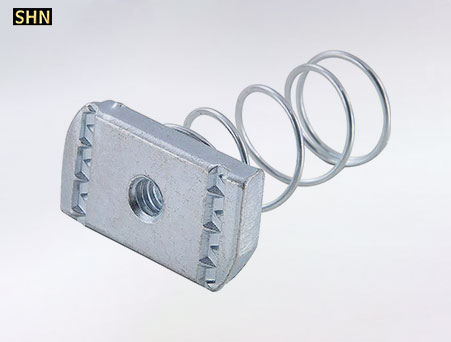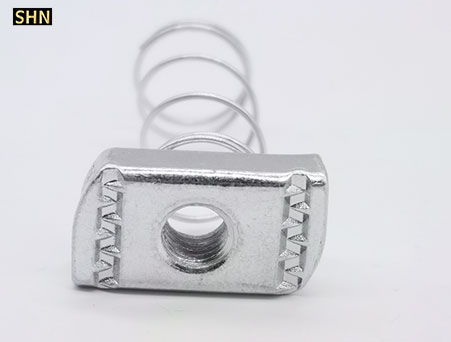+86 10 5248 4022
+86 18518927929

Mar. 19, 2024
Strut nuts play a crucial role in providing support and stability to various structures, from shelving units to automotive applications. One of the fundamental aspects to consider when dealing with strut nuts is their size. But what determines the size of a strut nut, and how can you ensure you select the right one for your project? In this comprehensive guide, we will delve into the intricacies of strut nut sizing, covering everything from measurement techniques to installation tips.

Strut nuts come in various sizes to accommodate different applications, but what factors influence their sizing?
Several factors come into play when determining the size of a strut nut. Firstly, the thread size and pitch are crucial considerations. These determine how the strut nut will fit onto the threaded rod or bolt. Additionally, the dimensions of the strut itself, such as its width and thickness, can influence the size of the nut required.
Thread size refers to the diameter of the threaded rod or bolt, while pitch represents the distance between individual threads. Matching the thread size and pitch of the strut nut to that of the rod or bolt is essential for a secure and stable connection. Using incompatible thread sizes or pitches can lead to issues such as loosening or instability.
Yes, there are standard sizes for strut nuts, typically based on industry standards such as those set by organizations like the American National Standards Institute (ANSI). These standard sizes ensure compatibility and interchangeability across different manufacturers and applications. However, custom sizes are also available for specialized projects that require specific dimensions.
Accurate measurement is crucial when selecting strut nuts for a project. But how do you measure strut nuts correctly to ensure the perfect fit?
To measure strut nuts accurately, you will need a few essential tools, including a caliper or ruler capable of measuring both diameter and length. A thread gauge can also be useful for identifying the thread size and pitch accurately.
Start by determining the thread size and pitch of the threaded rod or bolt that the strut nut will be used with. Next, measure the diameter and length of the strut nut using a caliper or ruler. Compare these measurements to standard sizes or specifications provided by the manufacturer to ensure compatibility.
One common mistake when measuring strut nuts is inaccurately identifying the thread size or pitch. This can lead to purchasing the wrong size nut, causing compatibility issues during installation. Another mistake is neglecting to account for variations in thread standards between different regions or manufacturers, which can also result in mismatched components. Taking the time to measure accurately and double-checking measurements can help avoid these pitfalls.

Selecting the correct size strut nut is crucial to ensure the stability and reliability of your construction or support system.
Choosing the right size strut nut is essential for maintaining structural integrity and load-bearing capacity. A properly sized nut ensures a secure connection between components, preventing instability and potential failure in the system. By selecting the correct size, you can optimize performance and safety in your construction or support application.
Consider the specific requirements of your project when selecting the size of the strut nut. Factors such as load capacity, environmental conditions, and installation constraints will influence the choice of strut nut size. Additionally, ensure compatibility with other components in the system to achieve seamless integration and functionality.
Determine the load requirements of your application to select strut nuts with appropriate load capacities.
Consider the environmental conditions, such as exposure to moisture or corrosive substances, and choose strut nuts made from materials that offer corrosion resistance.
Take into account the installation method and available space to ensure the selected strut nuts can be easily installed and fit within the designated area.
When it comes to strut nuts, you have the option to choose between standard sizes and custom solutions based on your project requirements.
Standard-sized strut nuts offer convenience and availability, as they are readily accessible from manufacturers and suppliers. They adhere to common thread specifications and load capacities, making them suitable for a wide range of applications. However, standard sizes may not always meet the specific requirements of unique projects, necessitating the need for custom solutions.
Custom-sized strut nuts are ideal for projects with specialized requirements that cannot be met by standard sizes. Whether it's a non-standard thread size, unique load capacity, or specific material composition, custom solutions can be tailored to meet your exact specifications. While custom sizing may require additional time and cost, it ensures precise compatibility and performance in your application.
Consider the scope and requirements of your project when deciding between standard sizes and custom solutions. For standard applications with common specifications, standard-sized strut nuts may offer the most cost-effective solution. However, for projects with unique requirements or specialized components, investing in custom-sized strut nuts can provide long-term benefits in terms of performance and reliability.
The size of the strut nut, including its thread size, pitch, and overall dimensions, must align with the specifications of other components in the system, such as bolts, channels, and fittings. Incompatible sizes can lead to improper fitment, compromised structural integrity, and potential failure of the assembly.
Thread compatibility: Ensure that the thread size and pitch of the strut nut match those of the corresponding bolts or channels to facilitate secure connections.
Dimensional compatibility: Verify that the overall dimensions of the strut nut align with the available space and installation requirements within the system.
Material compatibility: Consider the material composition of the strut nut and other components to ensure compatibility with environmental conditions and application requirements, such as corrosion resistance and load-bearing capacity.
Consult manufacturer specifications and guidelines to ensure compatibility between strut nuts and other components in the system.
Conduct thorough measurements and inspections to verify compatibility before installation, especially in critical or high-load applications.
Consider using compatible accessories, such as washers or locking devices, to enhance the stability and reliability of the connection between strut nuts and related parts.
By prioritizing compatibility and selecting compatible components, you can enhance the performance and longevity of your construction or support system while minimizing the risk of compatibility-related issues.
Mismatched thread specifications: Inaccurate identification of thread size or pitch can lead to compatibility issues. Use thread pitch gauges and reference guides to ensure accurate identification.
Dimensional discrepancies: Inconsistencies in overall dimensions can result in improper fitment within the system. Verify measurements using precise tools and techniques to avoid sizing discrepancies.
Retrofitting solutions: In cases where strut nuts with incompatible sizes have been installed, consider using adapters, spacers, or custom-made components to achieve compatibility.
Replacement options: If sizing discrepancies cannot be resolved through retrofitting, consider replacing the strut nuts with appropriately sized alternatives to ensure compatibility and performance.
Conduct test fittings: Perform trial installations using sample components to verify compatibility and identify any sizing issues before full-scale installation.
Seek expert guidance: Consult with manufacturers, suppliers, or industry professionals for assistance in troubleshooting sizing problems and finding suitable solutions for your specific application.
Verify compatibility: Double-check the compatibility between strut nuts and other components, including bolts, channels, and fittings, before proceeding with installation.
Confirm sizing accuracy: Ensure that the strut nuts are correctly sized and aligned with the specifications of the system to prevent fitment issues during installation.
Prepare the installation area: Clean and inspect the mounting surface to remove any debris or obstructions that may affect the installation process.
Align the components: Position the strut nuts and related components, such as bolts or channels, in their designated locations according to the installation plan.
Thread engagement: Carefully thread the strut nuts onto the corresponding bolts or channels, ensuring proper alignment and engagement to prevent cross-threading or damage to the threads.
Torque tightening: Use a torque wrench to tighten the strut nuts to the recommended torque specifications, ensuring uniform and secure fastening without over-tightening or under-tightening.
Final inspection: Conduct a visual inspection of the installed strut nuts to verify proper alignment, fitment, and tightness, making any necessary adjustments as needed.
Follow manufacturer guidelines: Adhere to the installation instructions provided by the manufacturer to ensure proper installation and compliance with industry standards.
Use appropriate tools and equipment: Utilize calibrated torque wrenches, thread-locking compounds, and other recommended tools and accessories to facilitate accurate and secure installations.
Perform regular maintenance: Periodically inspect and maintain installed strut nuts and related components to detect any signs of wear, corrosion, or damage and address them promptly to prevent structural issues or failures.
How do I determine the correct thread size and pitch for strut nuts?
Are there standard sizes available, or do I need custom-sized strut nuts for my project?
What factors should I consider when selecting strut nut sizes for specific applications?
Expert answers to common queries regarding sizing, compatibility, and installation
Thread size and pitch can be determined using thread pitch gauges and reference guides, while standard sizes are available for common applications, and custom-sized options can be tailored to meet specific project requirements.
Factors such as load capacity, environmental conditions, and compatibility with other components should be considered when selecting strut nut sizes to ensure optimal performance and reliability.
Proper installation techniques, including pre-installation checks, torque tightening, and regular maintenance, are essential for ensuring the stability and longevity of strut nut installations.
Remember to prioritize compatibility, precision, and attention to detail when selecting and installing strut nuts, and don't hesitate to consult with manufacturers, suppliers, or industry professionals for additional guidance and support. By taking proactive measures and adhering to best practices, you can achieve optimal results and build robust, reliable structures that stand the test of time.
Understanding Strut Nuts: What Size Fits Your Needs?
Mar. 19, 2024Understanding Spring Nuts: Your Ultimate Guide
Mar. 19, 2024How to Secure Unistrut to Steel: A Comprehensive Guide
Mar. 15, 2024Leave Message
Write down your urgent needs to get free samples, and to check our stocks

Copyright © SS&HN INDUSTRY GROUP Ltd. All Rights Reserved | Sitemap | Powered by 